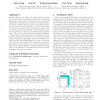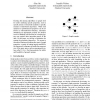86
Voted
KDD
2004
ACM
16 years 1 months ago
2004
ACM
Most data mining algorithms require the setting of many input parameters. Two main dangers of working with parameter-laden algorithms are the following. First, incorrect settings ...
112
click to vote
KDD
2004
ACM
16 years 1 months ago
2004
ACM
Privacy-preserving data mining has concentrated on obtaining valid results when the input data is private. An extreme example is Secure Multiparty Computation-based methods, where...
112
click to vote
KDD
2004
ACM
16 years 1 months ago
2004
ACM
The primary goal of Web usage mining is the discovery of patterns in the navigational behavior of Web users. Standard approaches, such as clustering of user sessions and discoveri...
KDD
2004
ACM
16 years 1 months ago
2004
ACM
Extensive studies have shown that mining microarray data sets is important in bioinformatics research and biomedical applications. In this paper, we explore a novel type of genesa...
KDD
2004
ACM
16 years 1 months ago
2004
ACM
Procedures for collective inference make simultaneous statistical judgments about the same variables for a set of related data instances. For example, collective inference could b...
KDD
2004
ACM
16 years 1 months ago
2004
ACM
Existing data mining algorithms on graphs look for nodes satisfying specific properties, such as specific notions of structural similarity or specific measures of link-based impor...
88
Voted
KDD
2004
ACM
16 years 1 months ago
2004
ACM
The paper presents a method for pruning frequent itemsets based on background knowledge represented by a Bayesian network. The interestingness of an itemset is defined as the abso...
110
click to vote
KDD
2004
ACM
16 years 1 months ago
2004
ACM
We report on an automated runtime anomaly detection method at the application layer of multi-node computer systems. Although several network management systems are available in th...
128
click to vote
KDD
2004
ACM
16 years 1 months ago
2004
ACM
One fundamental challenge for mining recurring subgraphs from semi-structured data sets is the overwhelming abundance of such patterns. In large graph databases, the total number ...
129
click to vote
KDD
2004
ACM
16 years 1 months ago
2004
ACM
Many automated learning procedures lack interpretability, operating effectively as a black box: providing a prediction tool but no explanation of the underlying dynamics that driv...




